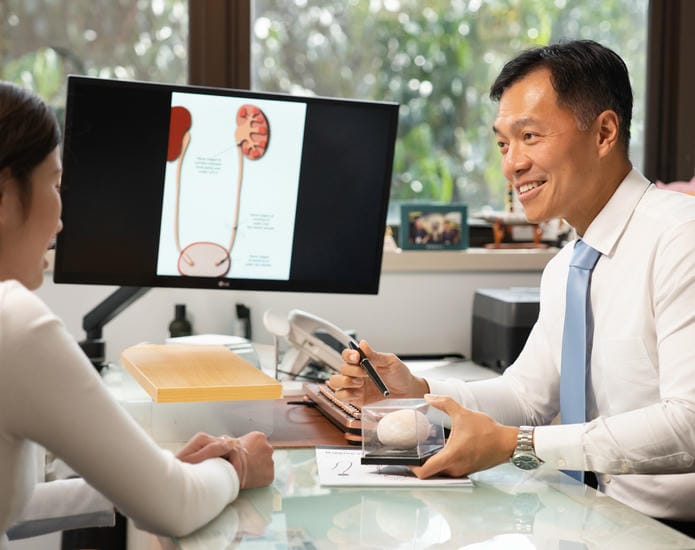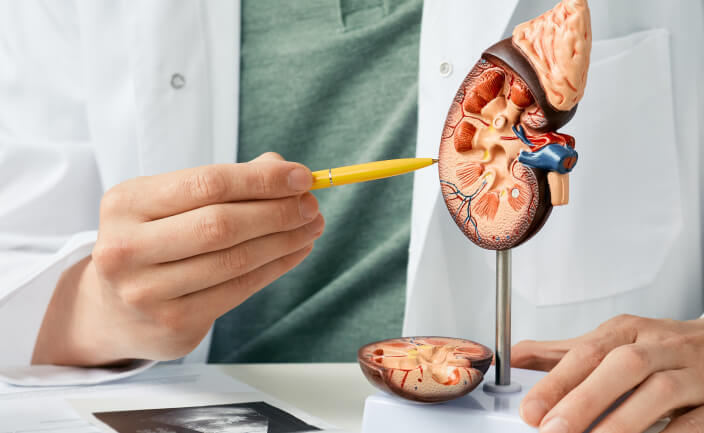Kidney stones are hard deposits of minerals and salts that form inside the kidneys. These stones vary in size and can cause significant discomfort and bleeding when they block the urinary tract. Early detection of kidney stone symptoms allows for timely management to prevent the condition from worsening.
How Are Kidney Stones Diagnosed?
To determine the presence, location, size, and composition of your kidney stones, your urologist may conduct lab or imaging tests. Once the presence of stones has been confirmed, an analysis of your passed stones may be done to form a suitable prevention plan.
Lab Tests
Blood testing
Blood tests can detect high levels of calcium or uric acid, indicating the presence of kidney stones. Results also help evaluate the function of your kidneys, which may prompt further investigations.
Urine testing
A urine sample is analysed to detect blood and stone-forming minerals. The presence of white blood cells and bacteria in the urine suggests you may have UTI.
Imaging Tests
Computed tomography (CT) scans
CT scans use a mix of X-rays and computer technology to produce images of your urinary tract. They reveal the size and location of a kidney stone, whether it obstructs the urinary tract and conditions that may have caused the stone to form.
Ultrasound
Ultrasound is a non-invasive test that uses sound waves to create a picture of your kidneys and bladder. This method can identify uric acid and other non-calcified stones if they are large enough.
Abdominal X-ray
Abdominal X-rays can show the location of stones in the urinary tract but are less frequently used because some stones will not be visible.
Analysis Of Passed Stones
You may be requested to urinate through a strainer to collect any passed stones. By analysing the stones, your urologist can identify their composition and utilise this data to determine the underlying cause of your kidney stones. This will help to avoid future occurrences.
Consult a urologist for a personalised management plan.
What Are the Treatments for Kidney Stones
Kidney stone treatment primarily depends on several factors, including the size, type, and location of the stones, as well as the patient's overall health. Several treatment options are available to break up or extract kidney stones, ranging from minimally invasive to surgical interventions.
Non-Invasive Kidney Stone Treatment
Extracorporeal Shock Wave Lithotripsy (ESWL)
During ESWL, shock waves are generated outside the body and focused on the kidney stones to break them down into smaller pieces, which can be passed out of the body through urine. First, your urologist will use an ultrasound or X-ray to locate the kidney stone. Once the stone is located, a machine will generate the shock waves and they will be delivered to the stone through a device placed against the skin.
When Can I Resume Daily Activities After ESWL?
Shockwave treatment for kidney stones is done on a day surgery basis and usually takes 50-70 minutes to complete. After the treatment, you may experience some pain or discomfort in the back or side where the stone is located. Blood may also be present in the urine. However, most patients can return to their daily activities within a few days.

Am I Suitable For ESWL?
Extracorporeal Shock Wave Lithotripsy (ESWL) works better with some stones than others and is more appropriate for certain people as X-rays and shock waves are used. Your urologist may recommend other types of kidney stone treatment if any of the following apply to you:
Bleeding disorders
Infections
Kidney abnormalities
Morbidly obese
Pregnant
Severe skeletal abnormalities
Using a cardiac pacemaker
Minimally Invasive Treatment for Kidney Stones
Ureteroscopy (URS)
During ureteroscopy, a thin viewing tube (ureteroscope) with a lens and light is inserted through the urethra and gently advanced to the bladder or ureter. Once the stone is located, your urologist will address it in one of two ways depending on its size:
- ● If the kidney stone is small, your urologist will use a scope to remove it from the ureter. The scope has a small basket attached to a wire, which is used to collect stones.
- If the kidney stone is larger, your urologist may use a high-energy laser beam to break the stone into fragments small enough to be passed through the urine (laser lithotripsy). This is considered a safe and effective method for kidney stone removal.
Ureteroscopy is usually performed under general anaesthesia, so you will not feel any pain or discomfort during the procedure.
When Can I Resume Daily Activities After Ureteroscopy (URS)?
If there are no complications, you can typically go home the same day. After the procedure, you may experience some discomfort or pain, and your urine may contain some blood. Your urologist will give you instructions on how to manage any discomfort or pain. Most people can return to their daily activities within a few days after the procedure.
Consult a urologist for a thorough assessment and personalised treatment recommendations.
Retrograde Intrarenal Surgery (RIRS)
RIRS is similar to ureteroscopy since it also involves inserting a ureteroscope through the urethra to the bladder under general anaesthesia. The main difference is that RIRS is more commonly used for stones located in the kidney. Once the scope is moved through the ureter to the kidney and the stone is seen, it can be fragmented by laser and extracted with small forceps or baskets.
When Can I Resume Daily Activities After Retrograde Intrarenal Surgery (RIRS)?
RIRS is done as a day procedure or with an overnight stay depending on the nature of the kidney stone. Once discharged, you may be advised to rest for a few days and avoid any strenuous activities for a week or so after the procedure. Pain medication may also be prescribed to manage any discomfort.
Percutaneous nephrolithotomy (PCNL)
When kidney stones are too large (exceeding 2 cm) or too complex for other less invasive methods, a percutaneous nephrolithotomy may be recommended for stone clearance. During the procedure, a tiny incision is made on the side of the back, through which a specialised tube (nephroscope) is inserted into the kidney. The urologist can directly visualise the stone and break it into smaller fragments using a laser device before removal. PCNL is often performed under general anaesthesia and may require a hospital stay for recovery.
When Can I Resume Daily Activities After PCNL?
After the procedure, you will likely need to stay in the hospital for a few days for observation and pain management. A catheter (nephrostomy tube) may be used to help drain urine from the kidney. Recovery time can vary depending on the size and complexity of the stone and the individual patient's overall health.
FAQs About Kidney Stones Removal Treatments

Our Urologist
FRCS(UROL) (RCPSG), FAMS(UROL)
Dr Lincoln Tan is a consultant urologist and accredited robotic surgeon who specialises in various kidney stone removal procedures. He previously served as the Director of Urologic Oncology at the National University Hospital (NUH) and the National Cancer Institute of Singapore (NCIS). He is currently a Visiting Consultant at NUH. Known for his patient-centric approach, Dr Tan is committed to providing comprehensive care for patients with kidney stones, using advanced techniques to ensure optimal outcomes.
Let us help you recover to a stone-free life.

Location
6 Napier Road #05-03,
Gleneagles Medical Centre,
258499, Singapore
Contact Us
| Phone |
: +65 6732 6503 |
| : info@tanurology.com.sg |
